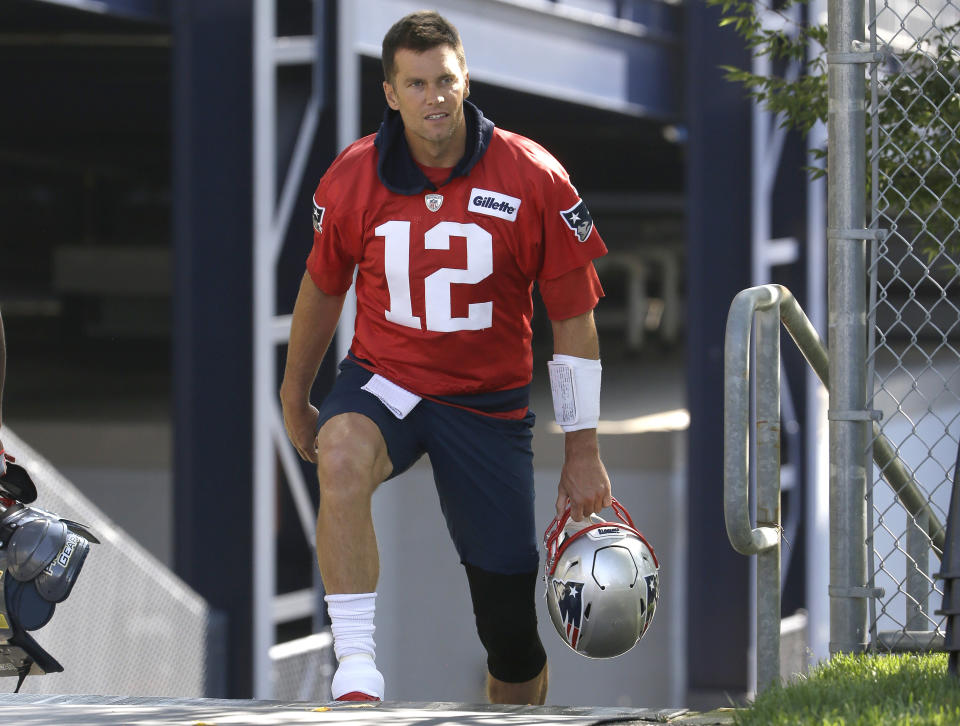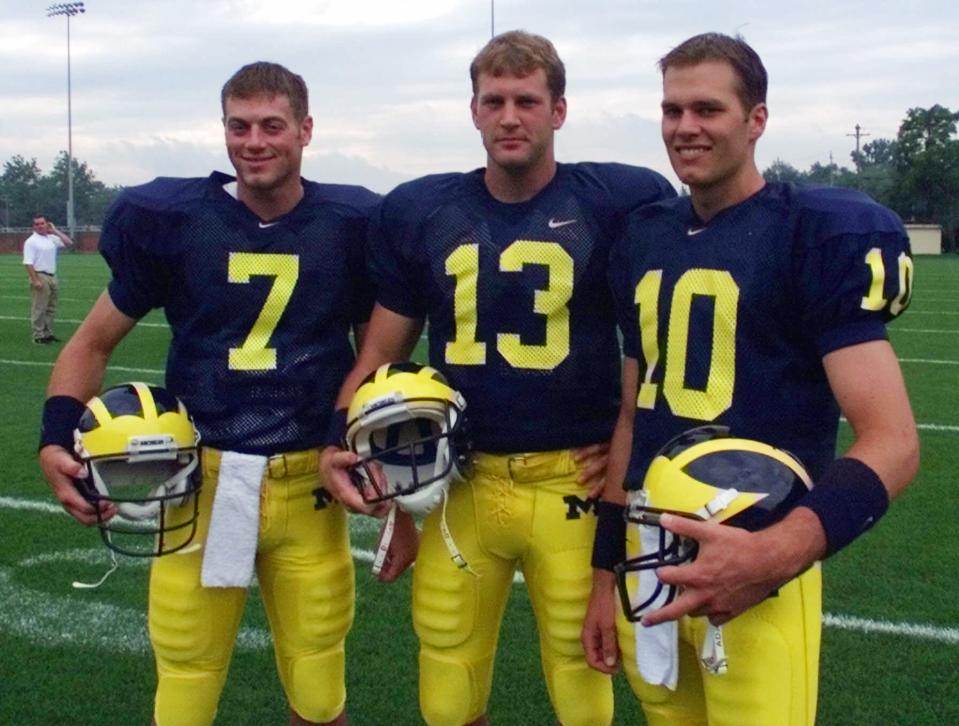As Tom Brady enters 20th season, one Patriots scouting trip in 2000 can't be overlooked
ALLEN PARK, Mich. – Maybe it’s fitting that on the day Tom Brady and the New England Patriots reportedly agreed to a contract extension that could run him through the 2021 season (and past his 44th birthday), he and team arrived here for a week of joint practices and a preseason game with the Detroit Lions.
This is a business trip that sits just 35 miles east of another, long-ago business trip; one that proved to be among the most important, if unlikely, in Patriots history.
In the spring of 2000, New England quarterbacks coach Dick Rehbein arrived at the University of Michigan to scout a player no NFL team seemed to want, who played a position that the Patriots didn’t need any help, and was a draft mystery in part because he’d been saddled in college with a system of shared-starting that perhaps no one ever heard of before.

And yet Tom Brady wound up a Patriots draft pick (199th overall) and all these years later (and apparently up to three seasons into the future), here we are, Brady and New England back in Michigan preparing for a run at their seventh Super Bowl.
I got a chance to hold my draft card a few hours ago. Never forget where you came from. pic.twitter.com/sqBgAbWLCZ
— Tom Brady (@TomBrady) August 4, 2019
The spring of 2000 constituted the first few months of the Bill Belichick regime. After being fired from Cleveland, Belichick vowed that if he ever got a second chance, he’d run an operation that would leave no stone unturned.
That meant having Rehbein, among others, focus on possible mid-round quarterbacks in the NFL draft even though the Pats already had three-time Pro Bowler Drew Bledsoe, plus two capable backups in young project in Michael Bishop and a veteran in John Friesz.
The team needed to draft talent everywhere … except QB.
“We had a lot of rebuilding to do in 2000, 2001,” Belichick said years later. “We had a few good players, but once you got past those guys, there were a lot of things that needed to be changed.”
Rehbein did his job though and Brady’s name kept coming up. He didn’t look the part of an NFL QB. His 6-foot-4 frame was still thin and undefined. He wasn’t fast. He didn’t have perfect footwork. He never looked particularly smooth in drills, especially at the NFL scouting combine.
Yet he had delivered in games. His senior season he completed 61.9 percent of his passes and threw for 16 touchdowns against just six interceptions. More important, he led the Wolverines to victories over five ranked opponents, including Notre Dame, Penn State and Alabama, not to mention archival Ohio State.
Doubts remained though because for half of his senior season, he was forced to share the starting job with a former local high school star named Drew Henson who was heavily hyped by fans and media. Even Michigan coach Lloyd Carr, who declared Henson “without question is the most talented quarterback that I’ve been around.” Tom was good, but no one thought he was that.
In Brady’s senior season, Carr employed a system where one player would start the first quarter and then the other the second quarter. Then at halftime, the coaching staff would evaluate who was doing better. That QB would play the second half.
It was unorthodox, if not bizarre; disjointed if not doomed for failure. Brady won the second half starting job in four of the first five games as Michigan jumped to a 5-0 record. Yet in Game 6, at rival Michigan State, Henson got the second half start but struggled. The Spartans took a 27-10 lead before Brady was sent back in. He led a big comeback only to fall short, 34-31. With that, Carr had finally seen enough. Brady was the full-time starter.
“Tom separated himself, Carr said.
The problem for NFL scouts was that he hadn’t separated himself sooner. It’s understandable why front offices would write off a guy who had to share a starting job – especially since Henson also played minor league baseball and wasn’t even fully committed to football. (He’d later play for both the New York Yankees and the Dallas Cowboys)
It was a scarlet letter of sorts that overshadowed Brady's actually very strong play as a senior.
The Patriots instead went beyond the narrative and kept seeing those comeback drives and big wins. They liked that Brady was a captain. They liked that he didn’t transfer early in his career and decided to stick it out and fight for playing time, including dealing with this wild system. And, they figured, if he was pegged as a backup in the NFL, it was probably good experience having had to share the starting job and thus come off the bench.
Bobby Grier, the Patriots’ player personnel director, was the only NFL executive who called Carr and asked about the situation with Henson.
“I told him, 'You will never regret drafting Tom Brady,'” Carr said.
Then there was Rehbein coming to Ann Arbor to watch Tom work out in person and talk with him. The more they saw and listened, the more convinced they were that this was a good player coming out of a tough situation, something Carr kept repeating.
“I've always respected and admired Tom,” Carr said at the time. “Not just as a quarterback but as a leader. I assure you he did not want to share the quarterback job and yet as the head coach, it's my decision to look at the big picture. There aren't many guys I have coached that could handle the situation like Tom did, and that is one of the reasons I felt comfortable in doing it because I knew what kind of a guy he is made of. In the long term, I think Tom will be able to say it was the most difficult situation he has been in.”

With Rehbein’s groundwork, the Patriots tabbed Brady as about a third-round pick. That didn’t mean they were going to take him in the third round. Again, they didn’t need a QB. They needed everything else, so they took it … two offensive linemen, a running back, a tight end, a defensive tackle, a defensive back.
Yet as the sixth round began, Brady was still there. No one wanted him. New England couldn’t believe it. He was so overvalued as a sixth-rounder, Belichick decided to grab him.
Brady did enough to impress as a rookie the Patriots did another unusual thing – they kept four quarterbacks. Friesz was moved to the practice squad because Belichick didn’t want another team getting Brady, so he had to use a roster spot to protect him.
By 2001, it all proved genius. Bledsoe was hurt early in the season. Brady, always ready, stepped in and never relinquished the starting job. What he did to the Big Ten, he did to the NFL. He has never had the strongest arm or the fleetest feet. He won a Super Bowl in his first year as a starter though. There have been five more since.
The credit goes to Belichick’s aggressive scouting system and Dick Rehbein’s legwork in Ann Arbor that got him past conventional wisdom.
Rehbein died on Aug. 6, 2001 – 18 years ago Tuesday. It was before Brady could become a starter and prove the scout right, but as the Patriots return to Michigan for a week of work, with Brady fresh off agreeing to a contract that might push him into his 22nd year in the NFL, that original Patriots business trip out here ought to be remembered.
More from Yahoo Sports:

